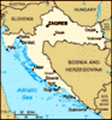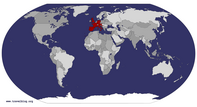Advertisement
Published: June 10th 2011

 Dubrovnik 5
Dubrovnik 5
Views of rooftops from city wallsFrom Krka to Mlini
11th May to 9th June
Nearly a month has passed since we left Krka National Park. The sun has been almost ever present in that time, disappearing just once or twice as the clouds sweep down off the mountains that run parallel to the beautiful by rocky coastline here. The speed of our travels has slowed down somewhat, especially for the last few weeks where we’ve taken advantage of the weather conditions after finding a quiet campsite in the lovely setting of Mlini, just south of Dubrovnik. We’ve not had too many troubles in the last month. The worst being my sunburn from Paklenica got worse, a lot worse as I hadn’t moisturised it at all, and my whole torso came up in blisters. Not just once, as soon as the blisters had popped they came back a few days later. All in all I must have lost at least three layers of skin. Fortunately I had managed to buy some moisturiser at this point so started to apply it, which on freshly blistered skin was a little more painful than you’d wish for. Thankfully since then I’ve been a little more sensible. I invested big
bucks in some Lidl sunscreen and have not burnt since. No more dramas to report than that!
Going back to the 11th May, we left Krka, to head the few kilometres back to the coast to Sibenik. The lovely port town, whose main attraction was the white cathedral dating back to the 15th century. It was nothing to look at from the outside, and I found the charm to lie in the typically narrow and steep alleyways of the beautiful old town to be more enthralling. The cathedral was quite something once inside. The white marble had all aged and was more grey and black in parts, but that gave it an amazing look. Unfortunately we weren’t allowed to take any photos so I only have one or two, taken when nobody was paying much attention, but they didn’t come out very well taken from waist height on the move!
After getting annoyed due to sitting in a traffic jam at roadworks in the middle of Trogir the following day, we skipped the town and found a campsite, but I resolved to go back the next day, and park outside the city and to walk in. It’s a

 Trogir 1
Trogir 1
Old Palimentary buildingpopular spot for tourists and so with half dug up roads and plenty of coaches and cars trying to navigate their way through a junction which appeared to have no right of way, it’s no wonder there were queues. I was quite happy walking by, and probably hide time to eat an ice cream or three before they had managed to park. The unusual part about Trogir is that the old town, and main visitor attraction, is situated on a small island. It’s only separated from the mainland by about twenty metres, and it appears you are just crossing a river to get to it at first until you actually walk around the whole of it and realise. It’s a really beautiful spot. The grand houses and political buil;dings lining the shoreline have an amazing setting, the one main alleyway is equally old and beautiful. It is quite small though, and doesn’t take an age to look around. I did spend a while climbing the bell tower of a church. After paying to go in, I was about to walk out after two minutes disappointed at the underwhelming building. I then spotted the tower stairs and started to climb. When
I got to the top, I was quite pleased with myself. I was glad nobody else was around to see me almost wetting myself as I climbed the old steps and ladders. Being scared of heights is quite rational I think, at times anyway, but it’s not very macho! It was worth it though, the view of the roofs of the buildings was lovely, and I enjoy looking at the photos a lot more than I did at the time of taking them!
The Makarska Riviera was once a big tourist area. Based north and south along the coast from the town of Makarska, the rugged coastline is beautiful. The crystal clear blue sea washes up onto the stony beaches. Not a sand one in sight. It’s a really nice area, but as I was told by one of the locals, there is nothing to see in particular, it’s all the same, nice, but all the same. There are no large hotels, most of the accommodation is apartments, presumably attached to the owners house. It makes for a really lovely drive, but not somewhere to add to your must see before you die lists, if you have one of

 Ston
Ston
City walls with salt farm in the backgroundcourse.
Continuing the nice slow paced drive along the coast aiming for Orebić, we stumbled upon Ston. A few coaches in the carpark, and another campervan made us pull in, deciding that there must be something to see. On having a proper look around, the town seemed quite pleasant, nice and old and full of charm. But the walls looked quite impressive to, they seemed to even stretch up the hill behind the town. The information board actually said they were the longest in Europe, hard to believe I though, until I started to climb them, they went on forever. They also seemed completely out of place. The village they surrounded was tiny, how could a village such as this have afforded to build them in the first place? They also surrounded the hill, upon which the residence sat of the lord who owned the old salt farm. So that was where the money came from, but even so, the walls seemed a bit too much. I suppose it shows how much we would pay for salt back in this area’s heyday.
Then it was on to Dubrovnik, somewhere I always expected to be nice, it’s the biggest

 Dubrovnik 1
Dubrovnik 1
Now town and harbourtourist ‘attraction’ in Croatia, and it didn’t disappoint. The city walls stretch unbroken around the old town, 2km in total. Whilst they aren’t the longest they are said to be the finest in Europe. But it’s the views from the walls rather than the walls themselves which is truly memorable. You could stop every few metres and take a photo, as the town seems to change from every angle. A 2km walk took almost 2 hours, as you climb towers to get another view. It’s the rooftops that seem amazing, dotted with the odd church tower, or other grand building. The pastel almost peach colour of the once terracotta coloured roof tiles. The shelling of the city in the Bosnian war caused international condemnation, and you can understand why. What could the Serbs hope to gain by trying to destroy this ancient city? Nothing but a political manoeuvre aimed at destroying one of Croatia’s landmarks. Dubrovnik was once Ragusa, a maritime independent city state. They competed with Vienna to be the dominant merchant force in the Mediterranean, so a trip to the maritime museum was quite interesting. One thing that amused me was that nearly all their fleet from the19th
century onwards was built in the UK, Glasgow, and Teesside in the main. Dubrovnik is set up for tourism, but unlike many places, it doesn’t take away from the charm of the city, the many people wandering the streets don’t seem out of place, although I may have a different opinion if I visited during the peak summer season. There is of course the customary Irish bar, but even that seems to fit in nicely, in an old alleyway. Apart from one main street, the old town is only narrow alleyways, some flat, others steep, others along long steps up the Cliffside. It must be packed with people in July and August, but I don’t think that would matter, if anything it would add to the atmosphere with all the outdoor restaurants and bars full. Definitely worth another visit, if only to sit, eat and drink and enjoy the atmosphere.
Since Dubrovnik we’ve been in Mlini, a small town a few km’s south of Dubrovnik. Time has been well spent soaking up the rays, with the occasional swim in the Adriatic Sea, both me and the dog, although not at the same time! The town has the usual array
of bars and restaurants, and you can walk along the coastal paths to the neighbouring towns of Srebreno, and Kupari. You notice a few things left over from the war. Old military hotels, run down, three large ones in Kupari. It’s an amazing sight to see these massive hotels, just completely stripped. One after another. I also walked up the mountains that line the coast, it’s only a 600m vertical climb but so steep it seems higher. The ridge is the border to Bosnia, and there are again signs of the war, with pill boxes lining the ridge. The most amazing thing about these was there were like new. The concrete looked as if it was set only a year ago. There are plenty of old food cans as well that have never been cleared. There is also the odd no entry side, and after various warnings from people and in the guide books, I didn’t go too far along those paths. Whilst I’m sure the landmines have long gone, or even if there was a stray one the chance would be low of me finding it, I do quite like my legs so was sensible and turned back!
It is a shame that this country and this whole area had to suffer so much in the early 90’s, and whilst they’ve rebuilt and demolished where needed, there are still a good few of it. The people are all so friendly and it’s definitely been one of my favourite countries so far.
From here it’s the ferry to Bari to tackle Italy. I hope it’s as nice as Croatia has been, I’m sure it won’t disappoint!
Do viđenja!
Advertisement
Tot: 0.106s; Tpl: 0.013s; cc: 11; qc: 52; dbt: 0.0735s; 1; m:domysql w:travelblog (10.17.0.13); sld: 1;
; mem: 1.2mb
















